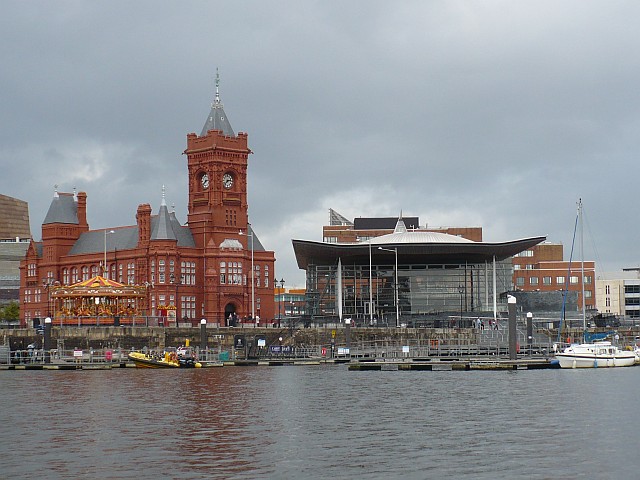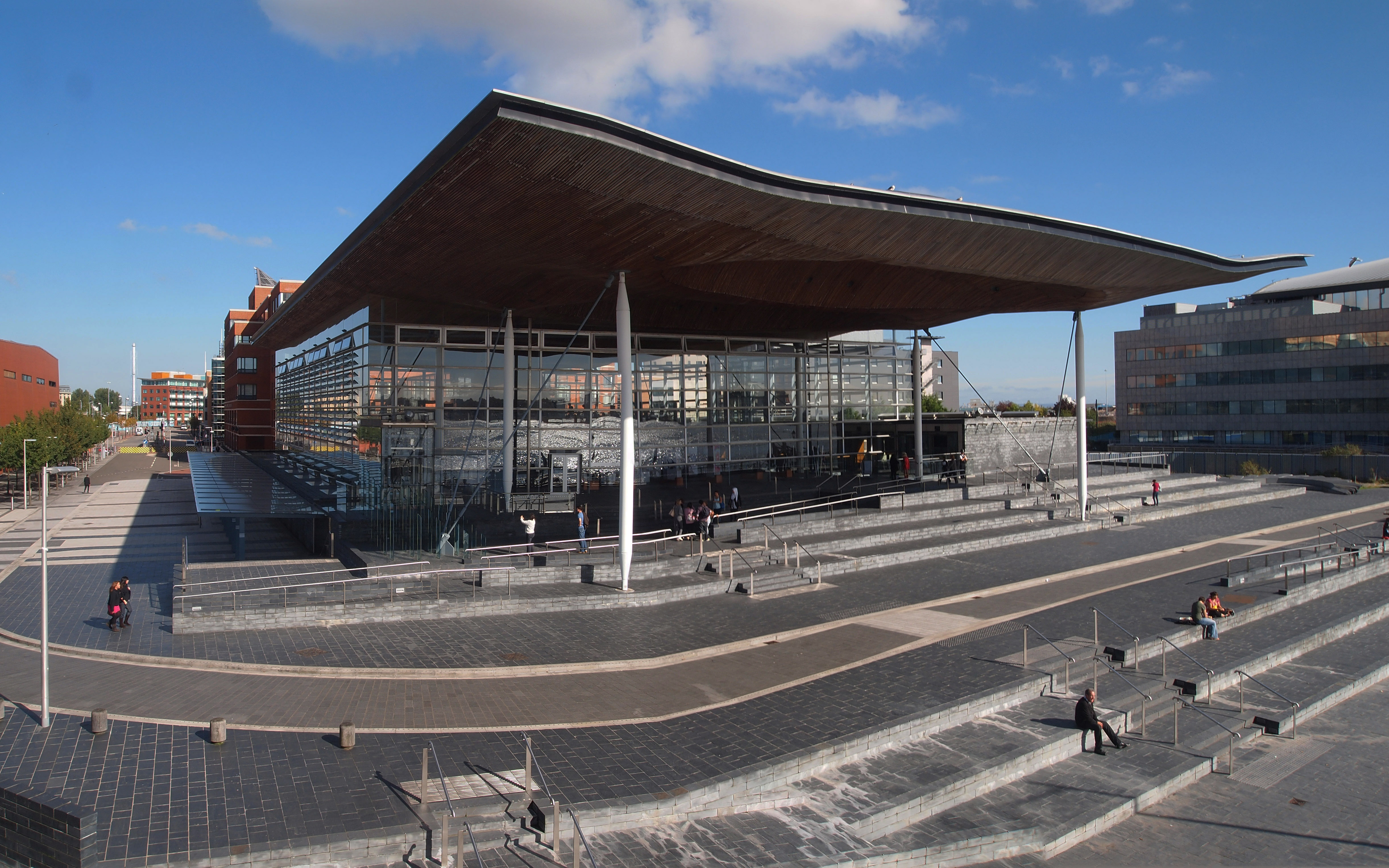|
Senedd Building
The Senedd building () in Cardiff houses the debating chamber and three committee rooms of the Senedd (Welsh Parliament; , formerly the National Assembly for Wales). The Senedd building was opened by Queen Elizabeth II on 1 March 2006, Saint David's Day, and the total cost was £69.6 million, which included £49.7 million in construction costs. The Senedd building is part of the Senedd estate that includes Tŷ Hywel and the Pierhead Building. After two selection processes, it was decided that the debating chamber would be on a new site, called Site 1E, at Capital Waterside in Cardiff Bay. The Pritzker Prize-winning architect Lord Rogers of Riverside won an international architectural design competition, managed by RIBA Competitions, to design the building. It was designed to be sustainable with the use of renewable technologies and energy efficiency integrated into its design. The building was awarded an "Excellent" certification by the Building Research Establishment Env ... [...More Info...] [...Related Items...] OR: [Wikipedia] [Google] [Baidu] |
Senedd Logo
The Senedd (; ), officially known as the Welsh Parliament in English and () in Welsh, is the devolved, unicameral legislature of Wales. A democratically elected body, it makes laws for Wales, agrees certain taxes and scrutinises the Welsh Government. It is a bilingual institution, with both Welsh and English being the official languages of its business. From its creation in May 1999 until May 2020, the Senedd was known as the National Assembly for Wales ( cy, Cynulliad Cenedlaethol Cymru, lang, link=no). The Senedd comprises 60 members who are known as Members of the Senedd (), abbreviated as "MS" (). Since 2011, members are elected for a five-year term of office under an additional member system, in which 40 MSs represent smaller geographical divisions known as "constituencies" and are elected by first-past-the-post voting, and 20 MSs represent five "electoral regions" using the D'Hondt method of proportional representation. Typically, the largest party in the S ... [...More Info...] [...Related Items...] OR: [Wikipedia] [Google] [Baidu] |
Cardiff Bay
Cardiff Bay ( cy, Bae Caerdydd; historically Tiger Bay; colloquially "The Bay") is an area and freshwater lake in Cardiff, Wales. The site of a former tidal bay and estuary, it serves as the river mouth of the River Taff and Ely. The body of water was converted into a lake as part of a UK Government redevelopment project, involving the damming of the rivers by the Cardiff Bay Barrage in 1999. The barrage impounds the rivers from the Severn Estuary, providing flood defence and the creation of a permanent non-tidal high water lake with limited access to the sea, serving as a core feature of the redevelopment of the area in the 1990s. Surrounding the lake is a area of redeveloped former derelict docklands which shares its name. The area is situated between Cardiff city centre and Penarth, in the communities of Butetown and Grangetown. Its waterfront is home to notable attractions, in particular regarding Welsh politics; with devolved institutions such as the Senedd buil ... [...More Info...] [...Related Items...] OR: [Wikipedia] [Google] [Baidu] |
Tonne
The tonne ( or ; symbol: t) is a unit of mass equal to 1000 kilograms. It is a non-SI unit accepted for use with SI. It is also referred to as a metric ton to distinguish it from the non-metric units of the short ton ( United States customary units), and the long ton ( British imperial units). It is equivalent to approximately 2204.6 pounds, 1.102 short tons, and 0.984 long tons. The official SI unit is the megagram (symbol: Mg), a less common way to express the same mass. Symbol and abbreviations The BIPM symbol for the tonne is t, adopted at the same time as the unit in 1879.Table 6 . BIPM. Retrieved on 2011-07-10. Its use is also official for the metric ton in the United States, having been adopted by the United States |
Cardiff Bay Barrage
Cardiff Bay Barrage ( cy, Morglawdd Bae Caerdydd) lies across the mouth of Cardiff Bay, Wales between Queen Alexandra Dock and Penarth Head. It was one of the largest civil engineering projects in Europe during construction in the 1990s. History Origin The origin of the scheme dates back to a visit by Nicholas Edwards, the Secretary of State for Wales, to the largely-derelict Cardiff docklands in the early 1980s. An avid opera enthusiast, Edwards envisaged a scheme to revitalise the area incorporating new homes, shops, restaurants and, as a centrepiece, an opera house at the waterside. However the tidal nature of Cardiff Bay, exposing extensive mudflats save for two hours either side of high water, was seen as aesthetically unappealing. Edwards credited the solution to this perceived problem to a Welsh Office civil servant, Freddie Watson. Watson proposed building a barrage stretching across the mouth of Cardiff Bay from Cardiff Docks to Penarth, which would impound freshw ... [...More Info...] [...Related Items...] OR: [Wikipedia] [Google] [Baidu] |
South Wales Coalfield
The South Wales Coalfield ( cy, Maes glo De Cymru) extends across Pembrokeshire, Carmarthenshire, Swansea, Neath Port Talbot, Bridgend, Rhondda Cynon Taf, Merthyr Tydfil, Caerphilly, Blaenau Gwent and Torfaen. It is rich in coal deposits, especially in the South Wales Valleys. Description It comprises a fully exposed synclinorium with a varying thickness of coal measures ( Upper Carboniferous/Pennsylvanian) with thick, workable seams in the lower parts and generally thinner and sparser seams in the upper parts, together with a development of sandstones ( Pennant Sandstone). These sandstones have been much used in building construction (including the characteristic terraces of former miners' houses) and give rise to bleak uplands rising 300–600 metres above sea level between the steep-sided valleys in which most deep mines were developed. The coal generally increases in grade or "rank" from east to west, with bituminous coals in the east, and anthracite in the west, m ... [...More Info...] [...Related Items...] OR: [Wikipedia] [Google] [Baidu] |
Cardiff Castle
Cardiff Castle ( cy, Castell Caerdydd) is a medieval castle and Victorian Gothic revival mansion located in the city centre of Cardiff, Wales. The original motte and bailey castle was built in the late 11th century by Norman invaders on top of a 3rd-century Roman fort. The castle was commissioned either by William the Conqueror or by Robert Fitzhamon, and formed the heart of the medieval town of Cardiff and the Marcher Lord territory of Glamorgan. In the 12th century the castle began to be rebuilt in stone, probably by Robert of Gloucester, with a shell keep and substantial defensive walls being erected. Further work was conducted by the 6th Earl of Gloucester in the second half of the 13th century. Cardiff Castle was repeatedly involved in the conflicts between the Anglo-Normans and the Welsh, being attacked several times in the 12th century, and stormed in 1404 during the revolt of Owain Glyndŵr. After being held by the de Clare and Despenser families for several c ... [...More Info...] [...Related Items...] OR: [Wikipedia] [Google] [Baidu] |
Cardiff Docks
Cardiff Docks ( cy, Dociau Caerdydd) is a port in southern Cardiff, Wales. At its peak, the port was one of the largest dock systems in the world with a total quayage of almost . Once the main port for the export of South Wales coal, the Port of Cardiff remains active in the import and export of containers, steel, forest products and dry and liquid bulks. History Following the development of the coal found in the Cynon Valley, Rhondda Valley, and Merthyr areas of South Wales, the export of both coal and iron products required a sea connection to the Bristol Channel if economic volumes of product were to be extracted. In 1794, the Glamorganshire Canal was completed, linking the then small town of Cardiff with Merthyr, and in 1798 a basin was built, connecting the canal to the sea. By the 1830s, Cardiff became the pre-eminent iron-exporting port, shipping almost half of British overseas iron exports; between 1840 and 1870, the volume of coal exports increased from 44,350 to 2.2 ... [...More Info...] [...Related Items...] OR: [Wikipedia] [Google] [Baidu] |
11 September Attacks
The September 11 attacks, commonly known as 9/11, were four coordinated suicide terrorist attacks carried out by al-Qaeda against the United States on Tuesday, September 11, 2001. That morning, nineteen terrorists hijacked four commercial airliners scheduled to travel from the Northeastern United States to California. The hijackers crashed the first two planes into the Twin Towers of the World Trade Center in New York City, and the third plane into the Pentagon (the headquarters of the United States military) in Arlington County, Virginia. The fourth plane was intended to hit a federal government building in Washington, D.C., but crashed in a field following a passenger revolt. The attacks killed nearly 3,000 people and instigated the war on terror. The first impact was that of American Airlines Flight 11. It was crashed into the North Tower of the World Trade Center complex in Lower Manhattan at 8:46 a.m. Seventeen minutes later, at 9:03, the World Trade Center’s Sout ... [...More Info...] [...Related Items...] OR: [Wikipedia] [Google] [Baidu] |
Stirling Prize
The Royal Institute of British Architects Stirling Prize is a British prize for excellence in architecture. It is named after the architect James Stirling, organised and awarded annually by the Royal Institute of British Architects (RIBA). The Stirling Prize is presented to "the architects of the building that has made the greatest contribution to the evolution of architecture in the past year". The architects must be RIBA members. Until 2014, the building could have been anywhere in the European Union, but since 2015 entries have had to be in the United Kingdom. In the past, the award included a £20,000 prize, but it currently carries no prize money. The award was founded in 1996, and is considered to be the most prestigious architecture award in the United Kingdom. The Stirling Prize replaced the RIBA Building of the Year Award. The Stirling Prize is the highest profile British architectural award, and the presentation ceremony has been televised by Channel 4. Six shortlisted ... [...More Info...] [...Related Items...] OR: [Wikipedia] [Google] [Baidu] |
BREEAM
BREEAM (Building Research Establishment Environmental Assessment Method), first published by the Building Research Establishment (BRE) in 1990, is the world's longest established method of assessing, rating, and certifying the sustainability of buildings. More than 550,000 buildings have been 'BREEAM-certified' and over two million are registered for certification in more than 50 countries worldwide. BREEAM also has a tool which focuses on neighbourhood development. Purpose BREEAM is an assessment undertaken by independent licensed assessors using scientifically-based sustainability metrics and indices which cover a range of environmental issues. Its categories evaluate energy and water use, health and wellbeing, pollution, transport, materials, waste, ecology and management processes. Buildings are rated and certified on a scale of 'Pass', 'Good', 'Very Good', 'Excellent' and 'Outstanding'. It works to raise awareness amongst owners, occupiers and designers of the benefits of ... [...More Info...] [...Related Items...] OR: [Wikipedia] [Google] [Baidu] |
RIBA Competitions
RIBA Competitions is the Royal Institute of British Architects' unit dedicated to organising architectural and other design-related competitions. Architectural design competitions are used by an organisation that plans to build a new building or refurbish an existing building. They can be used for buildings, engineering work, structures, landscape design projects or public realm artworks. A competition typically asks for architects and/or designers to submit a design proposal in response to a given brief. The winning design will then be selected by an independent jury panel of design professionals and client representatives. The independence of the jury is vital to the fair conduct of a competition. The objective of a competition is to explore a range of different design options to select the best response to the design brief, which would not be possible by pre-selecting one architect. The competitions process is often used to generate new ideas, create blue-sky thinking, stimu ... [...More Info...] [...Related Items...] OR: [Wikipedia] [Google] [Baidu] |







